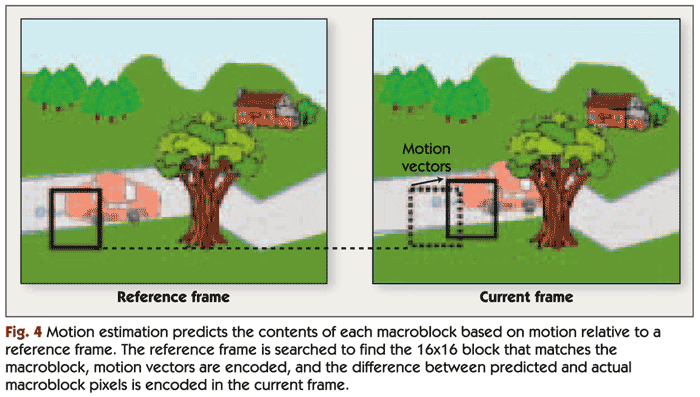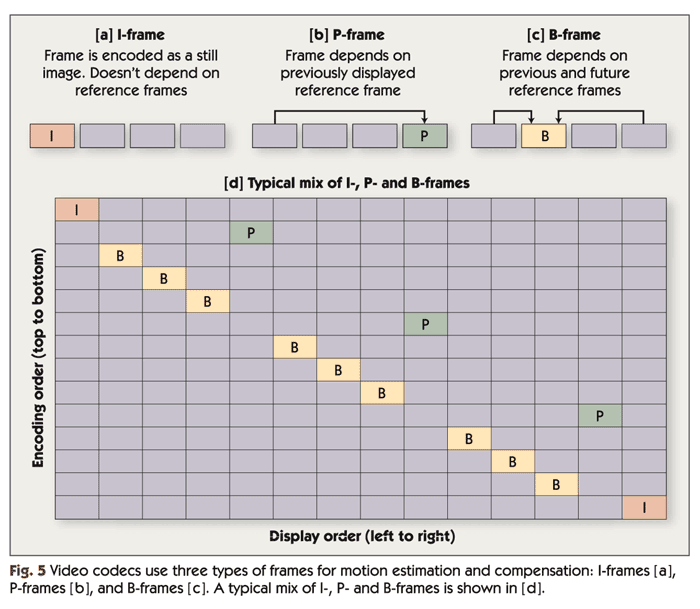Color and motion
Working with color
Color images are typically represented using several "color planes." For example, an RGB color image contains a red color plane, a green color plane, and a blue color plane. When overlaid and mixed, the three planes make up the full color image. To compress a color image, the still-image compression techniques described earlier can be applied to each color plane in turn.
Imaging and video applications often use a color scheme in which the color planes do not correspond to specific colors. Instead, one color plane contains luminance information (the overall brightness of each pixel in the color image) and two more color planes contain color (chrominance) information that when combined with luminance can be used to derive the specific levels of the red, green, and blue components of each image pixel.
Such a color scheme is convenient because the human eye is more sensitive to luminance than to color, so the chrominance planes can often be stored and/or encoded at a lower image resolution than the luminance information. Specifically, video compression algorithms typically encode the chrominance planes with half the horizontal resolution and half the vertical resolution of the luminance plane. Thus, for every 16-pixel by 16-pixel region in the luminance plane, each chrominance plane contains one 8-pixel by 8-pixel block. In typical video compression algorithms, a "macro block" is a 16x16 region in the video frame that contains four 8x8 luminance blocks and the two corresponding 8x8 chrominance blocks.
Adding Motion to the Mix
Video compression algorithms share many of the compression techniques used in still-image compression. A key difference, however, is that video compression can take advantage of the similarities between successive video frames to achieve even better compression ratios. Using the techniques described earlier, still-image compression algorithms such as JPEG can achieve good image quality at a compression ratio of about 10:1. The most advanced still-image codecs may achieve good image quality at compression ratios as high as 30:1. In contrast, video compression algorithms can provide good video quality at ratios of up to 200:1. This increased efficiency is accomplished with the addition of video-specific compression techniques such as motion estimation and motion compensation.
For each macro block in the current frame, motion estimation attempts to find a region in a previously encoded frame (called a "reference frame") that is a close match. The spatial offset between the current block and selected block from the reference frame is called a "motion vector," as shown in Figure 4. The encoder computes the pixel-by-pixel difference between the selected block from the reference frame and the current block and transmits this "prediction error" along with the motion vector. Most video compression standards allow motion-based prediction to be bypassed if the encoder fails to find a good match for the macro block. In this case, the macro block itself is encoded instead of the prediction error.

Note that the reference frame isn't always the previously displayed frame in the sequence of video frames. Video compression algorithms commonly encode frames in a different order from the order in which they are displayed. The encoder may skip several frames ahead and encode a future video frame, then skip backward and encode the next frame in the display sequence. This is done so that motion estimation can be performed backward in time, using the encoded future frame as a reference frame. Video compression algorithms also commonly allow the use of two reference frames—one previously displayed frame and one previously encoded future frame.
Video compression algorithms periodically encode one video frame using still-image coding techniques only, without relying on previously encoded frames. These frames are called "intra frames" or "I-frames." If a frame in the compressed bit stream is corrupted by errors, the video decoder can "restart" at the next I-frame, which doesn't require a reference frame for reconstruction.
As shown in Figure 5, frames that are encoded using only a previously displayed reference frame are called "P-frames," and frames that are encoded using both future and previously displayed reference frames are called "B-frames." A typical sequence of frames is illustrated in Figure 5[d].

One factor that complicates motion estimation is that the displacement of an object from the reference frame to the current frame may be a non-integer number of pixels. For example, suppose that an object has moved 22.5 pixels to the right and 17.25 pixels upward. To handle such situations, modern video compression standards allow motion vectors to have non-integer values; motion vector resolutions of one-half or one-quarter of a pixel are common. To support searching for block matches at partial-pixel displacements, the encoder must use interpolation to estimate the reference frame's pixel values at non-integer locations.

 How video compression works 2/5 - Quantization, coding, and p...
How video compression works 2/5 - Quantization, coding, and p...